You’ve been (hopefully) sticking close to home and avoiding crowded stores for over three weeks now. If, like us, you’re peering into your pantry to find naught but potatoes, rice, and stale bread, we have just the thing for you: historical recipes!

Our ancestors were exceptionally skilled at making food last. They weren’t able to flit to the corner store to pick up a few staples or summon UberEats deliveries. Largely, they had what they had until they could grow more. Have stale bread? Make bread pudding or breadcrumbs. Have chicken bones or vegetable scraps? Make broth. Have a 10 lb. bag of rice but your significant other suddenly doesn’t like rice even though you’ve been making rice for years and he never complained before?
Anyway, when I look into my barren refrigerator and think, “what would my ancestors have made?” my next stop is Hoosier State Chronicles, which has nearly 1 million pages of freely-accessible digitized historical Indiana newspapers. Some of these include thousands of time tested recipes! Plugging in any given pantry staple brings up dozens of recipes. Granted, some are more useful than others (sadly, I think few of my loved ones would be tempted by a recipe for Tongue Toast), but by and large, these recipes are simple, economical, and delicious! Let’s take a tour through 19th century papers, using search terms for a few items I still have left in my house.
As the sage hobbit Samwise Gamgee once said, “Boil ’em, mash ’em, stick ’em in a stew!” One of the best things about potatoes is their versatility. That, and the fact that they can last for months if stored properly, make them the perfect pantry staple. Let’s take a look at several potato recipes from the April 15, 1876 issue of the Terre Haute Saturday Evening Mail.

This fairly basic recipe for mashed potatoes takes a wild turn towards the end when the author casually suggests making a mashed potato custard! Similar to the filling of a sweet potato pie, this recipe calls for boiled potatoes, milk, butter, eggs, sugar, and nutmeg. After consulting some modern recipes, I’ve made an educated guess as to the amount of each since, as with so many historical recipes, this one leaves much to be desired in the way of specificity.
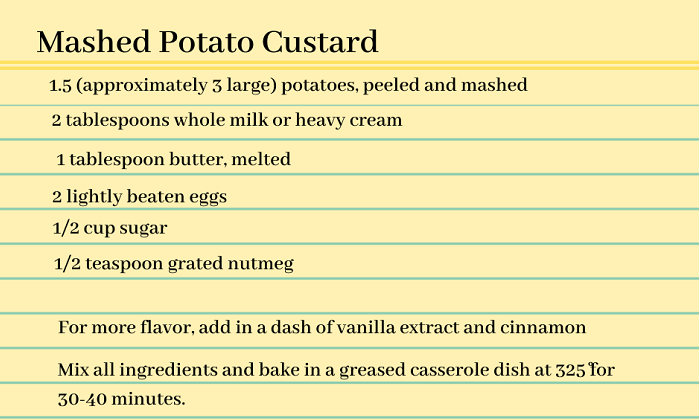
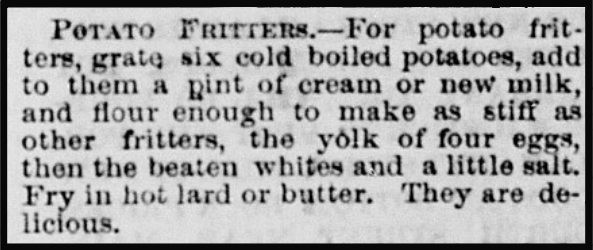
These potato fritters are – as advertised – absolutely delicious! I haven’t made every recipe in this post, but I have made these and I highly recommend them. They get even better if you add in a little bit of bacon, cheese, jalapeño, or anything else you have around the kitchen.

This “potato cake” recipe is basically just a recipe for delicious, always soft, and surprisingly healthy potato bread.

Remember the 10 lb. bag of rice I mentioned earlier? Despite what my husband has to say about it, I’m going to be making a lot of rice in the coming days. Luckily, I was able to track down some alternative uses from the 19th century that may help in this endeavor.

This simple rice pie can be enhanced with any number of additions. Add in raisins, prunes, and brown sugar, for a sweeter dish, or bacon bits, chives, and cheese for a more savory breakfast item. This recipe from Martha Stewart even adds in a bit of brandy into the mix.
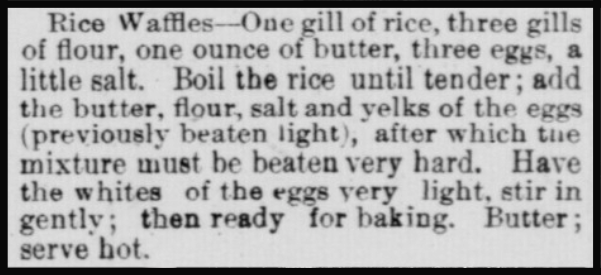
Rice . . . but make it waffles! This interesting take on waffles will mix things up at your breakfast table. I think since this recipe is on the simple side, it would be a great base to build upon. Top it with gravy. Or go the sweet route and top with fruit and syrup. Or go for the all-out savory dish and make these loaded rice waffles with sausage, spinach, tomatoes, and cheddar cheese. Since this recipe uses some outdated measuring terms (1 gill is roughly 1 cup), I’ve modernized it a bit below to make it easier to follow.
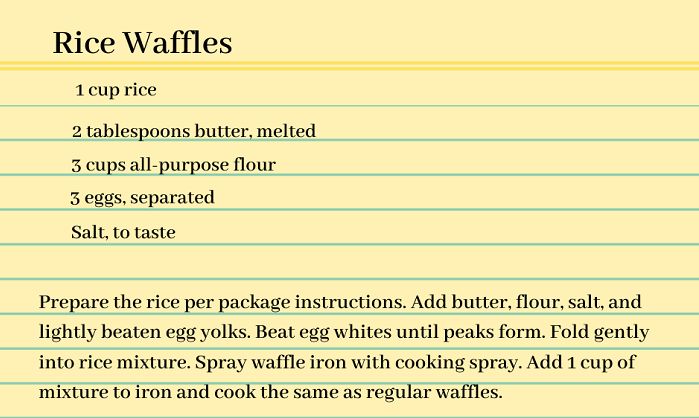
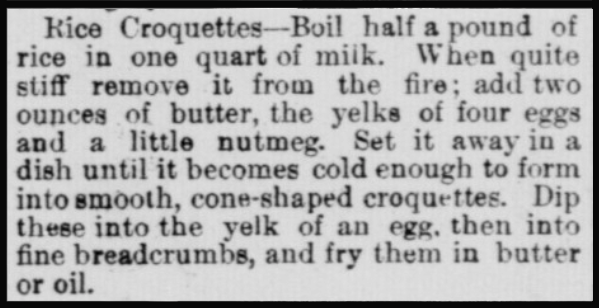
Now for something I had never heard of before – Rice Croquettes. These endlessly tweakable fried rice balls can be made to fit anyone’s palette. A quick online search reveals cheesy bacon croquettes, mozzarella croquettes, and ham and cheese croquettes.
Do you eat the heel of your bread loaves? If not, what do you do with them? Consider this – a typical loaf of bread contains twenty to twenty-four pieces including the heels. If you are in the habit of throwing away the heels, that means you’re throwing away 10% of every loaf of bread you buy. If your family eats a loaf of bread per week, you’re throwing away over five loaves of bread a year! Never waste a piece of bread again with these historical hacks for using even the hardest bits of stale (or unwanted) bread.
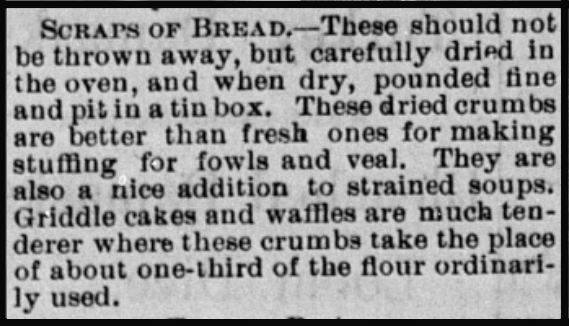
Breadcrumbs are an ever-useful thing to have around the kitchen. From coating your rice croquettes or chicken tenders for frying to filling out your meatballs, you’ll always find a use for these crumbs.

These coffee fritters use up your stale bread at double time – the fritters themselves are made of strips of stale bread and they’re coated in stale bread crumbs before being fried. Delicious with your morning coffee or afternoon tea, I’ve made this recipe and it’s mouthwatering just as it’s written.

My favorite thing to make with stale bread is bread pudding. Traditionally, like many English puddings, bread pudding is boiled in a pudding basin or a tightly woven cloth. See an example of this done with 18th century plum pudding here. More popular in America, though, is the baked version of this delectable dessert, so I’m including an example of each. Below is each recipe broken down and translated for the modern kitchen.
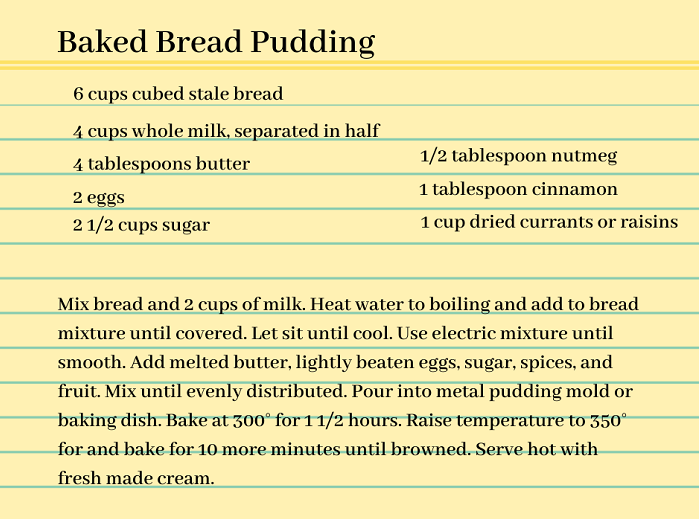
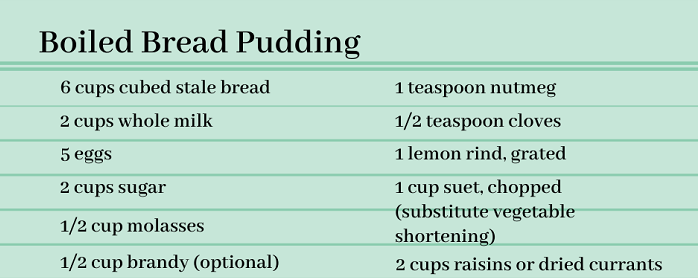
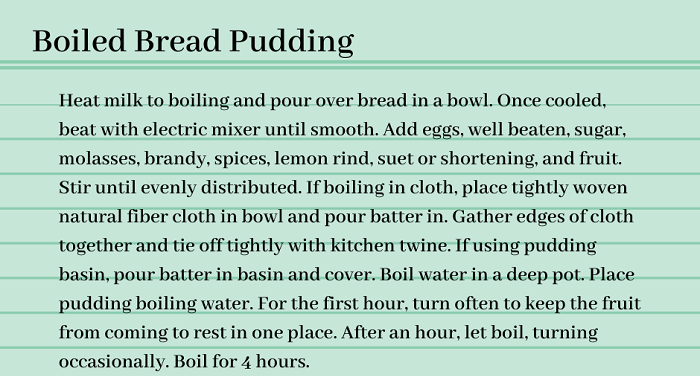
Serve warm with brandy sauce.
Want more recipes? From dried beans to pigs feet, there are recipes for just about any food item waiting to be found in the pages of historical Indiana newspapers. Show us what you make on twitter by tagging us @in_bureau!


